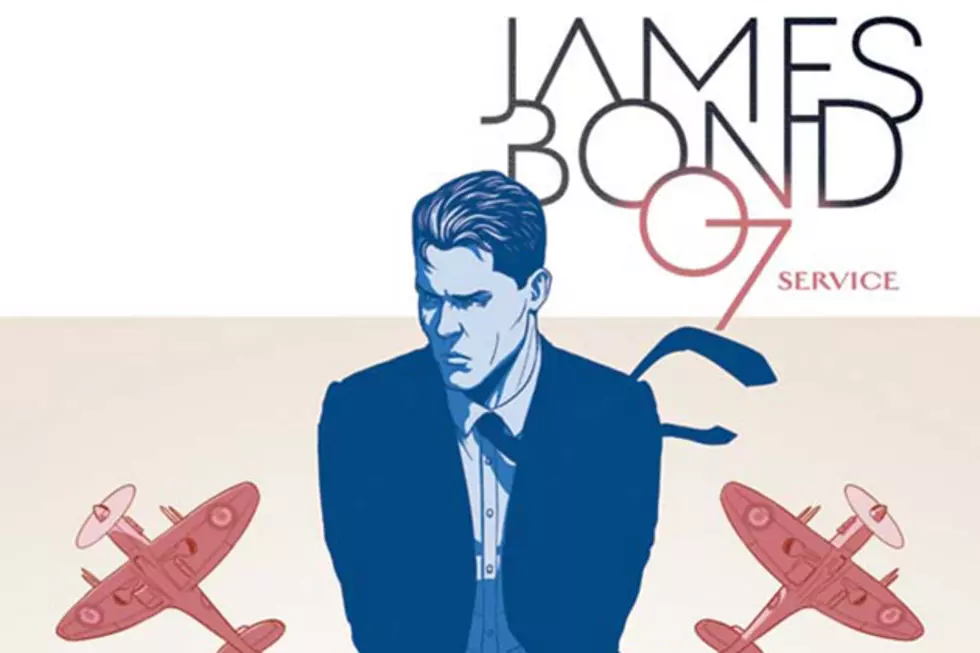
Strip Panel Naked: Eyeline Control in ‘James Bond: Hammerhead’
A big part about what makes comics work is eyelines. Over on my webseries I’ve talked before about Chris Samnee’s genius use of them on the current Black Widow series, but another great example caught my attention this week.
The opening page of James Bond: Hammerhead, by Luca Casalanguida, Chris Blythe, Andy Diggle and Simon Bowland struck me immediately. It brings you straight into the action with the rather dynamic, but simple, page design.
You’ve got one action here, that of 007 dropping out of the sky, floating down, and shooting this poor, helpless mercenary. The beauty comes from how Casalanguida frames and shapes objects to draw your eye to key information, without having to be really overt. This moment is meant to depict 007 coming from the shadows, arriving in the darkness and quietly getting the kill. So Casalanguida and Diggle have to sell the secrecy of the moment.
I’ve highlighted the lines of sight on each panel, and we’ll break down what they do and how they work. The first panel is the obvious one. A low angle look at the decrepit building, but what it cleverly does, beyond showing scale, is lead you up to where the moon is. And that’s where the other key information you need for the page is --- Bond silhouetted in the moon.
That continues through the other panels too, as we push in with the camera as Bond gets closer and closer. The lines of the building pull you across from left to right. Bowland places that text on the upper left to take your eye there first, then Casalanguida uses the canted angle and straight lines of the architecture to take you across to the right. It’s a pretty simple effect, guiding you with directions of lines, but it works to ‘reveal’ Bond on the far right, rather than giving him away straight away. The work of the eyelines means there doesn't need to be a big insert panel, or a sound effect pulling you directly to it, and it makes the whole procedure feel very stealthy --- ideally suited to this opening.
You see how it continues in the third panel, the lines from the architecture once again pulling you directly across to Bond, still in the darkness and background. The mercenary here is clearly the focal point, and once again Bowland brings the speech balloon to the left side of the frame, so you are guided left to right. This time the mercenary's eyes and gun help pull you across, with Bond now much larger.
The final panel has the big violent moment, and it works specifically because of the silence in all the previous three panels, setting up this trigger. It feels both predictable and like it’s coming out of nowhere.
Bowland brings the “fupp” sound effect into the middle of the page, so your eyes catch on the exploding head and blood first, then the silenced trigger, and finally Bond. The effect here is the sudden burst of violence. In panel three, we are drawn across to see Bond and his gun raised, then we look down and see a head bursting from the bullet.
This is a stunningly effective opening page, and it works because the art is informing the intentions of the writing --- the two of them working together to tell the same, complete, story. Above is the excerpt from Andy Diggle's script, and you can see from the opening paragraph that Diggle is already considering the visuals for the story.
I mentioned this last time, and no doubt it’s a constant theme of Strip Panel Naked, but comics are made particularly special when you can see all the creators working this harmoniously. Here is a wonderful example of writer and artist both coming together and understanding what makes the comics medium work, in magnificent fashion.
Check Out Some James Bond Facts You May Not Know
More From ComicsAlliance
![Bond After Brexit: Kieron Gillen Declassifies ‘James Bond: Service’ [Interview]](http://townsquare.media/site/622/files/2017/03/Service_McKelvie-feat.jpeg?w=980&q=75)








